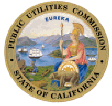 California Public Utilities Commission
California Public Utilities Commission
505 Van Ness Ave., San Francisco
________________________________________________________________________
PRESS RELEASE FOR IMMEDIATE RELEASE
Contact: Terrie Prosper, 415.703.1366, news@cpuc.ca.gov Docket #: Res E-4137
CPUC APPROVES FEED-IN TARIFFS TO SUPPORT DEVELOPMENT OF ONSITE RENEWABLE GENERATION
SAN FRANCISCO, February 14, 2008 - The California Public Utilities Commission (CPUC) today announced the availability of new tariffs to support the development of up to 480 megawatts (MW) of renewable generating capacity from small facilities throughout California. These "feed-in tariffs" present a simple mechanism for small renewable generators to sell power to a utility at predefined terms and conditions, without contract negotiations. The CPUC expects that participating facilities will sell their power to utilities and help contribute to California's ambitious greenhouse gas reduction and renewable energy goals.
"Up until now, only large renewable projects were able to effectively participate in the Renewables Portfolio Standard program," said CPUC President Michael R. Peevey. "Now small facilities can easily contribute to this program and be compensated for their renewable generation by signing up for these tariffs."
The power that is sold to the utilities under the feed-in tariffs will count toward the utilities' Renewables Portfolio Standard (RPS) goals. California's RPS program is one of the most ambitious renewable energy standards in the country. The RPS program requires electric corporations to increase procurement from eligible renewable energy resources by at least 1 percent of their retail sales annually, until they reach 20 percent by 2010. As of August 1, 2007, California's three large Investor-Owned Utilities collectively served 13.2 percent of their 2006 retail electricity sales with renewable power.
The small renewable generator feed-in tariffs available as of today provide a 10, 15, or 20-year fixed-price, non-negotiable contract to participating small renewable generators, sized up to 1.5 MW. Customers can sell renewable power under the feed-in tariff terms to Southern California Edison, Pacific Gas and Electric Company (PG&E), San Diego Gas and Electric Company, PacifiCorp, Sierra Pacific Power Company, Bear Valley Electric Service Division of Golden State Water Company, and Mountain Utilities. Any customer may sell to Edison or PG&E, but the feed-in tariffs are limited to water and waste water customers in the other four utilities.
The feed-in tariffs were developed pursuant to Public Utilities Code 399.20, established by Assembly Bill (AB) 1969 (2006, Yee) that directed the CPUC to develop feed-in tariffs to support the deployment of renewables specifically on publicly owned water and wastewater treatment facilities. In July of 2007, the CPUC adopted Decision (D.) 07-07-027 to implement AB 1969, and established the pricing terms for the tariffs. In the same decision, the CPUC expanded the feed-in tariff approach to non-water and non-wastewater facilities for only Edison and PG&E areas. By today's action, the CPUC adopted Resolution E-4137, which approves the feed-in tariffs submitted in compliance with D. 07-07-027.
"I am thrilled to see AB 1969 being expanded and offered to a broader audience of customers," said Senator Leland Yee. "AB 1969 will significantly help the state meet our renewable energy goals and improve the environment through a reduction in greenhouse gases."
The feed-in tariff option is distinct from net metering and direct financial incentives offered to customers to generate electricity onsite specifically to offset their own electrical load. Under the California Solar Initiative (CSI) and the Self Generation Incentive Program (SGIP), customers are offered upfront incentives to install solar, wind, and biogas generating capacity that can offset their customer load.
"Although many customers that want to pursue onsite generation to offset onsite load may be better served through existing programs like the CSI, SGIP and net-metering, this program allows those entities with significant onsite renewable generating potential, in excess of what they can use onsite, to be compensated for that generation," said President Peevey. "I believe this will be a particularly attractive option for those facilities that have access to a substantial biogas resource, like livestock operations and water and waste-water treatment facilities."
For more information on the CPUC, please visit www.cpuc.ca.gov.
###
